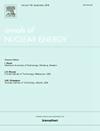Comparative study on the microstructural mechanism of thermal aging embrittlement in 17-4 PH and 15-6 PH stainless steels at 350 °C
IF 1.9
3区 工程技术
Q1 NUCLEAR SCIENCE & TECHNOLOGY
引用次数: 0
Abstract
As a valve stem material in nuclear reactors, 17-4 PH stainless steel tends to undergo thermal aging embrittlement at elevated temperatures. To address this, EDF recommends using 15-6 PH steel above 250 °C. However, limited studies compare the embrittlement mechanisms of these steels. This study subjected both to 3000 h of thermal aging at 350 °C and analyzed the mechanisms using aberration-corrected transmission electron microscopy (ACTEM). Both steels exhibited similar embrittlement levels, with Vickers hardness increasing by ∼29 %, though hardening was unsaturated. ACTEM revealed embrittlement caused by nano-sized Ni-Mn-Si particles and Cr-rich precipitates. In 17-4 PH, the α′ phase dominated embrittlement, while in 15-6 PH, Ni-Mn-Si particles and α′ phase contributed equally. These findings suggest future steel development should focus on controlling Ni content and adding elements to inhibit spinodal decomposition for improved resistance to thermal aging embrittlement.
17-4 PH和15-6 PH不锈钢350℃热时效脆化的显微组织机理比较研究
作为核反应堆阀杆材料,17-4 PH不锈钢在高温下容易发生热老化脆化。为了解决这个问题,EDF建议使用高于250°C的15-6 PH钢。然而,有限的研究比较这些钢的脆化机制。本研究在350°C下进行了3000 h的热老化,并使用像差校正透射电镜(ACTEM)分析了机理。两种钢表现出相似的脆化水平,尽管硬化是不饱和的,但维氏硬度增加了~ 29%。ACTEM显示,纳米Ni-Mn-Si颗粒和富cr析出物引起脆性。在17-4 PH下,α′相占主导地位,而在15-6 PH下,Ni-Mn-Si颗粒和α′相占主导地位。这些研究结果表明,未来的发展重点应放在控制Ni含量和添加抑制spinodal分解的元素上,以提高钢的抗热老化脆化能力。
本文章由计算机程序翻译,如有差异,请以英文原文为准。
求助全文
约1分钟内获得全文
求助全文
来源期刊

Annals of Nuclear Energy
工程技术-核科学技术
CiteScore
4.30
自引率
21.10%
发文量
632
审稿时长
7.3 months
期刊介绍:
Annals of Nuclear Energy provides an international medium for the communication of original research, ideas and developments in all areas of the field of nuclear energy science and technology. Its scope embraces nuclear fuel reserves, fuel cycles and cost, materials, processing, system and component technology (fission only), design and optimization, direct conversion of nuclear energy sources, environmental control, reactor physics, heat transfer and fluid dynamics, structural analysis, fuel management, future developments, nuclear fuel and safety, nuclear aerosol, neutron physics, computer technology (both software and hardware), risk assessment, radioactive waste disposal and reactor thermal hydraulics. Papers submitted to Annals need to demonstrate a clear link to nuclear power generation/nuclear engineering. Papers which deal with pure nuclear physics, pure health physics, imaging, or attenuation and shielding properties of concretes and various geological materials are not within the scope of the journal. Also, papers that deal with policy or economics are not within the scope of the journal.
 求助内容:
求助内容: 应助结果提醒方式:
应助结果提醒方式:


